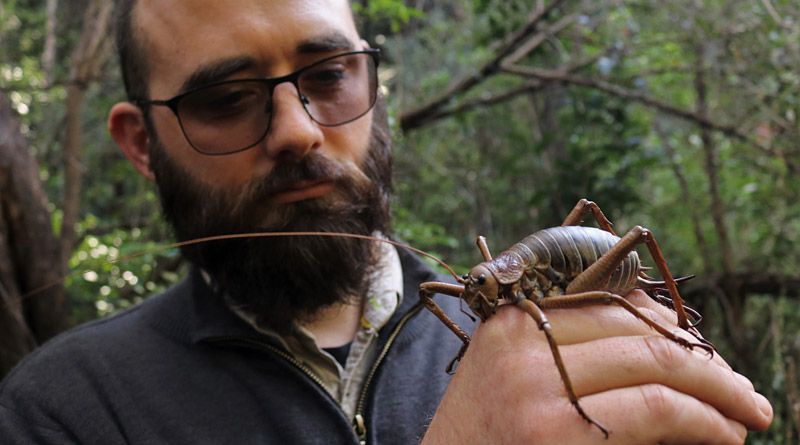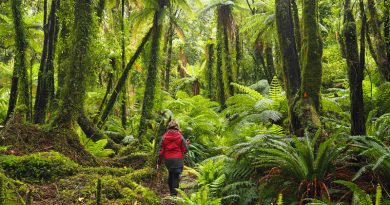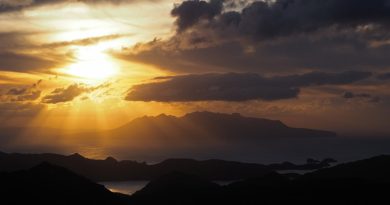Project Island Song: Return of the giants
I’ve been following an ambitious ecological restoration project in New Zealand’s Bay of Islands for almost 10 years now. This is my account of the changes I’ve seen, and an encounter with one of the world’s biggest, and most remarkable, insects.
Beauty, they say, is in the eye of the beholder — and to me she was unquestionably beautiful.
Her back was covered in armour plating and her legs bristled with spines. A long spike protruded from her rear and two antennae, even longer than her body, swept the air as she investigated her surroundings.
I whispered into her ears — conveniently located on her front knees — while her mouthparts gently tasted my skin to decide if I was a tree, food, or some other class of object.
She looked ancient, like a time traveller from the age of dinosaurs, but she was in fact much older.
Her ancestors were quietly going about their business in the treetops of primeval New Zealand for 120 million years before that show-off Tyrannosaurus rex started stomping around.
She was a wētāpunga, the biggest of New Zealand’s giant wētā and one of the biggest insects on Earth.
I’d wanted to hold one of these gentle giants ever since I was a child and saw a photo of a wētāpunga perched on a tramper’s boot on Hauturu [Little Barrier Island]. The image stuck with me because the insect was almost the size of the boot.
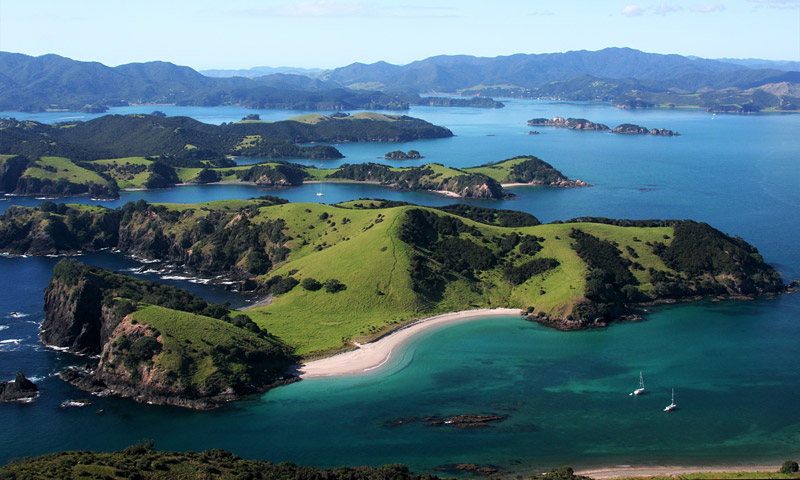
When I finally got my chance it was thanks to a Bay of Islands ecological restoration project called Project Island Song.
This community-driven, mostly volunteer-run project is working to return a string of islands between Russell and Cape Brett to something approaching their natural state before humans arrived — Europeans especially, with their deadly cargoes of rats, stoats, possums and feral cats.
By the 20th century, like much of Northland, the islands were almost stripped bare for farming and teeming with rodents. Native wildlife didn’t stand a chance.
Some species disappeared almost immediately — the wētāpunga was last seen in Northland in 1838 — while others clung on until the 1980s.
Project Island Song, which brings together the community group Guardians of the Bay, Rāwhiti hapū [sub-tribes] Ngāti Kuta and Patukeha, and the Department of Conservation, is an ambitious effort to turn back the clock.
Since the early 2000s volunteers have raised and planted more than 40,000 trees; in 2009 a series of poison drops and ground trapping wiped out introduced pests.
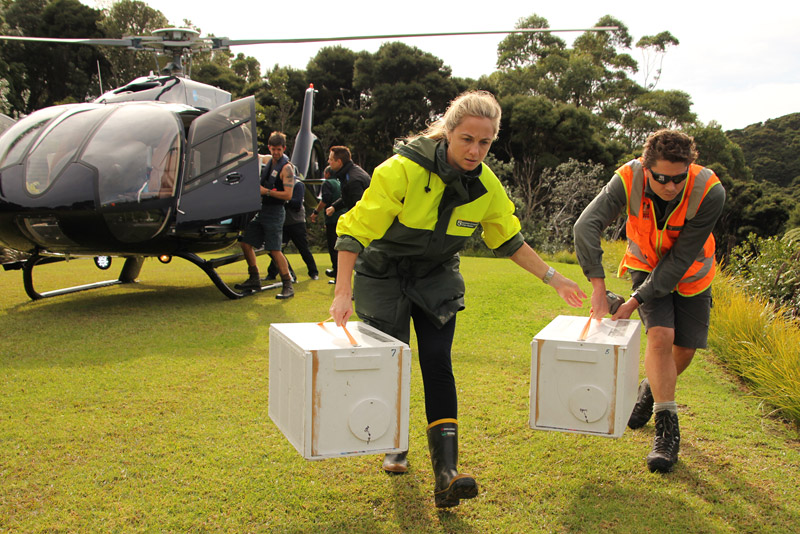
Then, in 2012, once the group had proved it could keep the islands pest-free, they started bringing back long-lost wildlife.
So far the tally stands at seven reintroduced species, mostly sourced from island nature sanctuaries like Tiritiri Matangi and Hauturu.
They include the kākāriki [red-crowned parakeet] and the tīeke or saddleback, named for the striking chestnut-coloured markings on its back. More recent translocations include Duvaucel’s gecko — New Zealand’s largest lizard — and giant wētā.
| Project Island Song timeline 2003: Replanting begins. 2009: Pests eradicated on the seven main islands of the Ipipiri group — Motuarohia, Moturua, Motukiekie, Urupukapuka, Waewaetorea, Poroporo and Ōkahu — plus a bunch of islets and rock stacks. 2012: Pāteke (brown teal), removed ahead of the poison drop, are returned. 2014: Toutouwai (North Island robins) released on Moturua. 2015: Tīeke (saddlebacks) released on Moturua and Urupukapuka. 2015: Pōpokotea (whiteheads) released on Motuarohia. 2016: Young tīeke are observed, proof the birds are breeding. 2017: A cat swims to shore from a yacht and roams Moturua for three weeks. It is eventually caught in a cage trap baited with tinned tuna. 2017: A Pacific gecko is seen on Moturua. 2017: Kākāriki (red-crowned parakeets) are released on Moturua. 2018: Duvaucel’s gecko, New Zealand’s biggest lizard, is released. The location is undisclosed due to poaching concerns. 2018: A kākāriki is seen on Bay of Islands mainland for first time in more than 50 years. 2019: Boaties setting off fireworks start a fire which destroys the vegetation on a small island. Only luck stops the flames jumping a small gap to Moturua and wiping out 10 years of restoration work. 2020: Wētāpunga (giant wētā) are released on Urupukapuka, Moturua and Motuarohia. 2021: A second release of kākāriki, this time on Urupukapuka. 2021: A second release of wētāpunga. |
Project coordinator Richard Robbins said the reintroduction of wētāpunga, the project’s first invertebrates, was a major milestone.
“Because of the name Project Island Song people think it’s all about birds but it’s so much more. It’s also invertebrates, it’s reptiles, it’s plants. We’re trying to recreate an entire ecosystem.”
When Project Island Song was launched 12 years ago it was described as one of the most ambitious ecological restoration projects attempted in New Zealand.
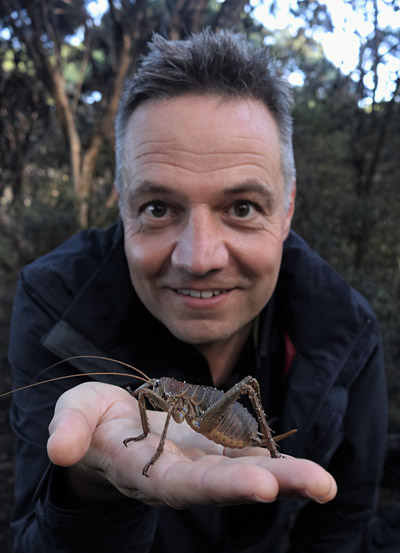
That wasn’t because of its size — with an area of about 600ha it’s relatively small — but because of the islands’ popularity and proximity to the mainland.
Every summer thousands of boaties and campers visit the islands, any one of whom could be carrying rodent stowaways.
Even without help predators can make it back. The 1km of water between Urupukapuka and the mainland at Rāwhiti is well within a rat’s swimming range.
As a result, the project’s volunteers and handful of paid workers need to be ever vigilant.
Monitoring is constant, as is boatie education. Hapū at Rākaumangamanga (Cape Brett) run a 4600ha pest control operation to keep mainland pest numbers down and reduce the risk of re-invasion.
The project has had its share of near-disasters.
Rats have made it back to the islands several times and cats have jumped off yachts and spent weeks wandering the islands.
In 2019 fireworks lit by boaties started a blaze which came within metres of wiping out 10 years of restoration work, and hundreds of endangered birds, on Moturua.
With those risks, however, comes great opportunity.
Many restoration projects are in isolated areas where their work goes unseen.
However, the Ipipiri islands, as they are collectively known, are easy to reach. Anyone with a small boat or a ferry fare can get a sense of what New Zealand used to be like, and could be again.
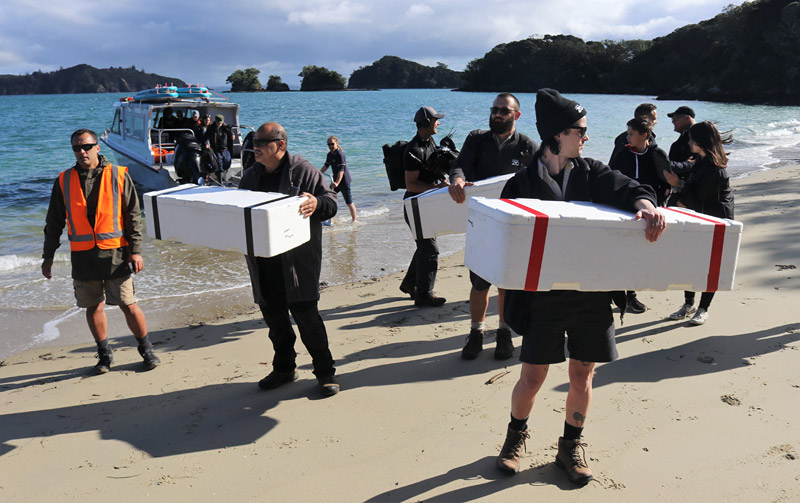
In the long term, efforts like Project Island Song can succeed only by persuading Kiwis the environment is worth preserving.
It’s only when you see a wētāpunga up close, or you’re mobbed by a bunch of raucous tīeke, that you really understand how extraordinary this country’s wildlife is.
That’s not lost on the project team, who operate a floating classroom bringing hundreds of children to the islands each year.
No more reintroductions are planned this year but Robbins’ wishlist for the near future includes the titipounamu or rifleman, New Zealand’s smallest bird, and the hihi or stitchbird.
Other species could include the Northland green gecko and invertebrates such as the Northland tusked wētā and the flax weevil. Bringing back the tuatara is another tantalising, but more distant, goal.
Robbins said work on the mainland was just as important as what was happening on the islands.
Pest control started at Rākaumangamanga to protect the islands but the area was becoming an ecological success story in its own right.
That meant birds would be able to spread from the islands to the mainland without being devoured by predators.
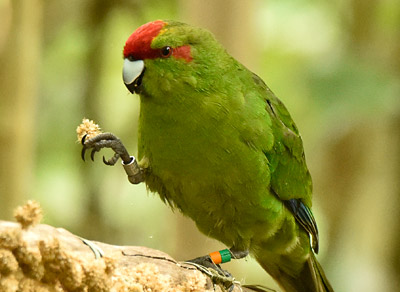
A kākāriki spotted in Paihia in 2018, for example, was the first one seen on the Bay of Islands mainland in 50 years.
“When people hear and see these species they understand how special New Zealand ecology is,” he said.
Robbins will know the project has truly succeeded when long-absent species start returning by themselves.
One such touchstone species would be the famously melodious korimako or bellbird.
The korimako has not been successfully reintroduced anywhere in New Zealand, which is thought to be due to the birds’ “incredibly complicated” social structure.
Also, because they are strong fliers, they can fly home if they don’t like the place they’re taken to.
Robbins said the only likely way of bringing back korimako was to keep improving the islands’ habitat — with year-round nectar-producing trees, for example — until the birds came of their own accord from the Poor Knights Islands off the Tutukaka coast.
| Giant wētā facts • The wētāpunga is one of the biggest insects on Earth. Adult females weigh about 40g or up to 70g when carrying eggs. That’s more than a small bird. • New Zealand has more than 70 species of wētā, including 11 types of giant wētā, but the wētāpunga is the biggest of them all. • Wētāpunga have been around for 190 million years. That makes even dinosaurs look like new kids on the block. • Wētāpunga are gentle giants. That big spike on the female’s rear end is not a stinger but an ovipositor, a tube for laying eggs in the soil. • Wētāpunga hide in punga fronds during the day and feed at night. Their favourite food is the leaves of native trees such as karaka, mahoe and kohekohe. • These herbivores produce some of the biggest faecal pellets — that’s poo in layman’s terms — in the insect world. It’s so big it’s often mistaken for rat poo. Wētāpunga keep the bush healthy by recycling nutrients from the tree tops back to the forest floor. • Wētāpunga shed their hard outer covering, or exoskeleton, 11 times as they grow. They reach adulthood in two years and live up to three years. • Wētāpunga used to be common in Northland and Auckland but introduced pests, especially ship rats, wiped them out. The last Northland sighting was at Paihia in 1838. • Until a few years ago wētāpunga survived only on Hauturu (Little Barrier Island). A breeding programme at Auckland Zoo has allowed the return of 6000 wētāpunga to the wild, mostly to the islands of the Hauraki Gulf. • Project Island Song, Auckland Zoo and Ngāti Manuhiri (the mana whenua of Hauturu) have so far re-introduced just over 200 wētāpunga to three islands in the Bay of Islands since 2020. |
I’ve been visiting the islands now for well over a decade.
It’s a short time in ecological terms but I’ve seen a remarkable change.
In the early 2000s they were mostly silent places, a sad contrast to the accounts of Captain Cook’s botanist Joseph Banks 250 years ago.
Banks described a cacophony of bird calls so loud it was impossible to have a conversation on deck, even when the ship was moored a quarter mile offshore.
But over the years the islands have become livelier and louder.
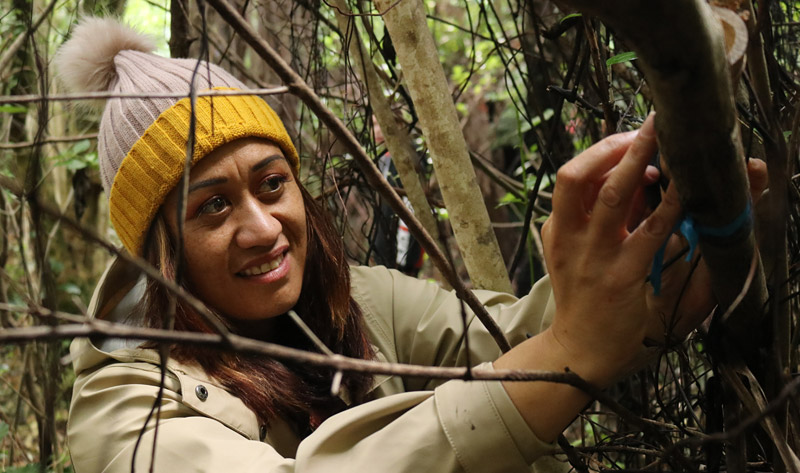
In June 2021 I joined a team from Auckland Zoo releasing wētāpunga on Moturua Island.
While I was in the bush several inquisitive toutouwai, or North Island robins, flitted down chirruping from the branches to investigate.
They were joined by a small flock of tīeke, chattering loudly as they hopped from twig to twig.
A few years ago the entire world population of North Island tīeke lived on one small island off Bream Bay.
Now there are an estimated 600 on Urupukapuka and Moturua, and so many making a racket that morning I couldn’t hear the person next to me.
It was a hint of how the New Zealand bush must have sounded before it was silenced by human carelessness, indifference and sometimes outright greed.
It was all the proof I needed Project Island Song is succeeding.

